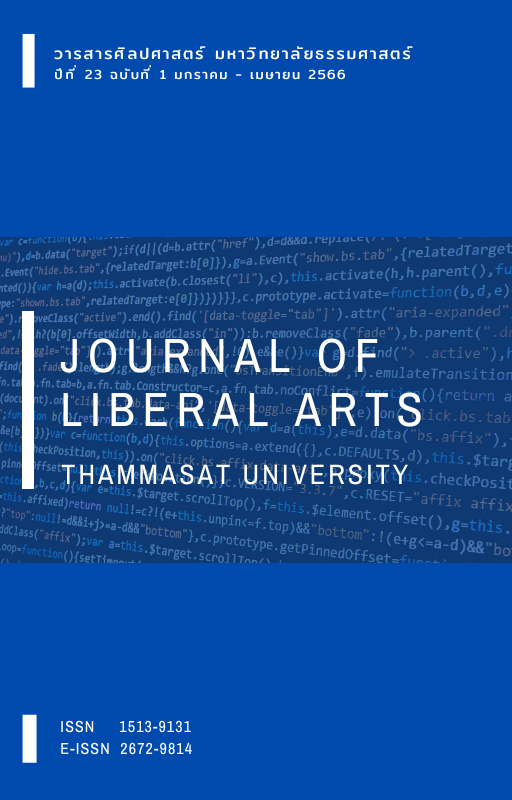Variables predicting ritualization of the Spring Festival among Chinese Thai youth in Hat Yai
Main Article Content
บทคัดย่อ
This study examined variables predicting ritualization of the Spring Festival among Chinese Thai youth in Hat Yai and created a prediction equation for the ritualization. The data were collected from 160 subjects who were selected using purposive sampling and data were analyzed using the R program to calculate Pearson’s product moment correlation coefficients and multiple linear correlation coefficients. The results of the study revealed seven predictors of ritualization of the Spring Festival among Chinese Thai youth in Hat Yai with predictability at a significance level of .001. Four predictors were found to have positive relationships with ritualization: family (X1), economy (X4), new media (X5), and governmental policy (X6). Governmental policy (X6) had the highest level of relationship, and family (X1) was the lowest.
Downloads
Article Details

อนุญาตภายใต้เงื่อนไข Creative Commons Attribution-NonCommercial-NoDerivatives 4.0 International License.
เอกสารอ้างอิง
Boonchom, A., & Preelekha, P. (2020). The cultural inheritance of language among people of Chinese heritage in the city of Sisaket, Sisaket province. Journal of Rattana Panna, 5(2), 195-212. [in Thai]
Buakaew, J. (2017). The existence of the tradition of Moon Festival in Hat Yai District, Songkhla Province. Journal of Liberal Arts, 9(2), 283-300.
Buakaew, J. & Janjula, J. (2015). Adaptation of Chinese New Year tradition among Thai Chinese in Songkhla province amidst modernization. Asian Social Science, 11(12), 144.
Buaphuan, N. (2017). The inheritance culture of Thai Chinese people in Doi Mae Salong, Chiang Rai Province. Dusit Thani College Journal, 11(3), 282-295.
Burgess, E. W., & Locke, H. J. (1945). The family: From institution to companionship. The American Book Company.
China Highlight. (2020). Chinese New Year Celebrations in 2020: Day-by-Day Guide. https://www.chinahighlights.com/travelguide/festivals/chinese-new-year-celebration.htm
Chitwiboon, P., & Tepsing, P. (2017). Ching Ming Tradition: Values towards Hat Yai Society. Nakhon Phanorm University Journal, 7(1), 72-80. [in Thai]
Cummings, R. L. (2014). Understanding the Thai-Chinese community in Hat Yai through the role of ethnic Chinese-affiliated organizations [Doctoral Dissertation]. Chulalongkorn University.
Dhammajong, N. (2016). The Roles of the Teochew Music and Cultural Learning Center in Photaram District, Ratchaburi Province, toward Chinese Ethnic Unification. Research and Development Institute, Loei Rajabhat University, 11, 18-24. [in Thai]
Guitong, M., Siripaisan, S., Saksoon, A. (2018). The “Guanxi” Culture and The Creation of Social Networks of Hakka Chinese in the Lower Southern Region of Thailand. Inthaninthaksin Journal, 13(2), 139-163. [in Thai]
Horton, P. B., & Hunt, C. L. (1980). Sociology. McGraw-Hill.
Kaewthep, K., Chaikunpol, N. (2012). A handbook of new media studies. Thailand Research Fund. [in Thai]
Kasikorn Bank Research Center. (2019). Chinese New Year: Opportunity for SME. Kasikorn Bank. [in Thai]
Kataoka, T. (2012). Religion as Non-religion: The Place of Chinese Temples in Phuket, Southern Thailand (< Special Issue> De-institutionalizing Religion in Southeast Asia). Southeast Asian Studies, 1(3), 461-485.
Krueaphat, K., & De Jong, P. (2018). Cultural Preservation of Mahayana Buddhist Identity in the Dimension of Chinese Shrines: Case Studies of Muang Phuket District, Phuket Province. Journal of International Studies, Prince of Songkla University, 8(2), 109-144.
Lakhanapipat, C., Smit, I., & Tubsree, C. (2016). Leadership Development in the One Tambon One Product (OTOP) Scheme in Thailand. HRD Journal, 7(1), 36-46.
Liang, S. (1973). History of Chinese Culture (3rd ed.). Kor Kai.
Luengsaksri, N. (2019). Worship Traditions in Chinese New Year: Origin, Meaning and Changes. Journal of Research and Development Institute, Rajabhat Maha Sarakham University, 6(1), 383-394. [in Thai]
Ministry of Tourism and Sport. (2012). Strategies of the Ministry of Tourism and Sport. Ministry of Tourism and Sport. [in Thai]
Mueansit, A. (2010). Man and Society. Tripple Education. [in Thai]
Office of the Council of State. (1999). National Education Act 2542 B.E. Ministry of Education. [in Thai]
Pawat. (2018). History of Chinese New Year, Background of the Chinese New Year Festival. http://www.parwat.com/19
Phonphong, S., Laphawatthanaphan, B., & Nuan-neit, P. (2007). The knowledge set of communication arts. Chulalongkorn University.
Ren, Q. (2015). A common knowledge about Chinese culture (Revised ed.). Xi’an, Shanxi Normal University.
Sankaburanurak, S. (2016). Project Evaluation of Chinese Art, Language and Culture Tour of Teaching Chinese as a Foreign Language Major, Faculty of Education Silpakorn University. Payap University Journal, 26(2), 55-73. [in Thai]
Satiman, A., Jaroenjittakam, S., Bangthamai, E., & Ruangrit., N. (2013). The Development of Multimedia for Learning on Bang Luang’s Chinese Music. Silpakorn Educational Research Journal, 5(1), 34-47. [in Thai]
Seangtian, N., & Sodsongkrit, M. (2017). Reflections of Chinese Governmental Communications for Hospitality in Chinese Culture. Journal of Language, Religion and Culture, 6(2), 185-220. [in Thai]
Sengpracha, N. (1994). Sociology (2nd ed.). Pitak Aksorn. [in Thai]
Siripaisan, S. (2007). Hatyai Chinese. Thaksin University.
Sodsongkrit, M. (2013). A Survey of Chinese Religious Places in Southern Provinces in the Northeast Region of Thailand. Journal of Liberal Arts, Ubon Ratchathani University, 9(1), 117-147. [in Thai]
Sowcharean, S., & Yongphet, B. (2016). Dhepbhudtharam: Reflection of the Way of Life and Beliefs of Thai-Chinese in Chon Buri. Academic Journal of Humanities and Social Sciences Burapha University, 24(45), 91-101. [in Thai]
Sritharet, P. (2017). Thai-Chinese Social and Cultural Capital for Promoting the Religious and Cultural Tourism in Ubon Ratchathani Province. Journal of Humanities and Social Sciences, Ubon Ratchathani Rajabhat University, 8(1). 230-243. [in Thai]
Steger, M. (2017). Globalization: A very short introduction (4th ed.). Oxford University Press.
Thai-Chinese Culture and Economy Association. (2017). Regulation of Thai-Chinese Culture and Economy Association. https://www.thaizhong.org/th/about-us/regulations.html [in Thai]
Ungsitipoonporn, S. (2014). Revitalization of Indigenous Hakka food: Challenges in adversity. Silpakorn University Journal, 34(3), 43-64. [in Thai]
Wattanarong, K. (2011). Increasing the reliability and acceptance of online media. https://www.thairath.co.th/content/181957 [in Thai]
Wiratchai, N. (1999). LISREL Model, Statistical analysis for research. Department of Education Research.
Zhao, Y. (2017). Beijing’s Business Association Thailand: Socio-cultural roles in Thai society. Liberal Arts Review, 12(23), 11-23.


